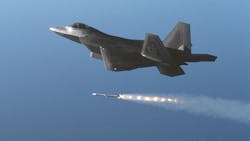Raytheon to build 58 AIM-9X short-range infrared-guided air-to-air missiles for the Navy and Air Force
PATUXENT RIVER NAS, Md. – U.S. Navy aerial warfare experts are asking Raytheon Technologies Corp. to build 58 AIM-9X precision short-range infrared-guided air-to-air missiles for jet fighters and other combat aircraft under terms of a $34.7 million order announced Monday.
Officials of the Naval Air Systems Command at Patuxent River Naval Air Station, Md., are asking the Raytheon Missiles & Defense segment in Tucson, Ariz., to build 58 lot-20 AIM-9X block II air-to-air missiles for the U.S. Navy and Air Force.
The AIM-9X is an infrared-guided heat-seeking missile that equips most jet fighters, fighter-bombers, and other offensive combat aircraft in the U.S. arsenal, and is for shooting down enemy aircraft close-by. The AIM-9X works by homing in on an enemy aircraft's hot engine exhaust. Variants of the AIM-9 Sidewinder have been deployed since the 1950s.
The order includes 61 block II captive air training missiles; 35 all-up round containers; and one lot of spares for the governments of Finland, Israel, the Netherlands, Norway, Singapore, Turkey, and Poland.
The AIM-9X is among the latest versions of the AIM-9 missile family. It entered service in 2003 on the Navy F/A-18C Hornet fighter-bomber and on the U.S. Air Force F-15C jet fighter. It has an imaging infrared focal plane array seeker with 90-degree off-boresight capability for accuracy.
The missile is compatible with helmet-mounted displays such as the U.S. Joint Helmet Mounted Cueing System, and features 3-D thrust-vectoring control for increased turn capability. The AIM-9X also includes an internal cooling system.
This contract involves the latest versions of the AIM-9X, called the AIM-9X block II. This newest version has lock-on after launch capability for use with the F-35 Lightning II joint strike fighter and the F-22 Raptor advanced tactical fighter.
On this order Raytheon will do the work in Tucson, Ariz.; Andover and Amesbury, Mass.; Keyser, W.Va.; Santa Clarita, Goleta, San Jose, Valencia, Anaheim, El Cajon, San Diego, Chatsworth, and Claremont, Calif.; Hillsboro, Ore.; Ottawa, Ontario; Cheshire and Simsbury, Conn.; Heilbronn, Germany; Cincinnati; Anniston, Ala.; Sumner, Wash.; and other U.S. locations, and should be finished by July 2023.
For more information contact Raytheon Missiles & Defense online at www.raytheonmissilesanddefense.com, or Naval Air Systems Command at www.navair.navy.mil.

John Keller | Editor-in-Chief
John Keller is the Editor-in-Chief, Military & Aerospace Electronics Magazine--provides extensive coverage and analysis of enabling electronics and optoelectronic technologies in military, space and commercial aviation applications. John has been a member of the Military & Aerospace Electronics staff since 1989 and chief editor since 1995.

